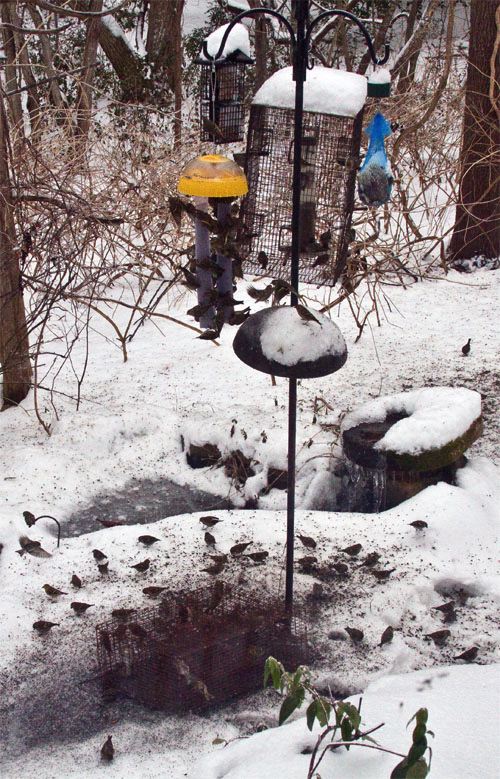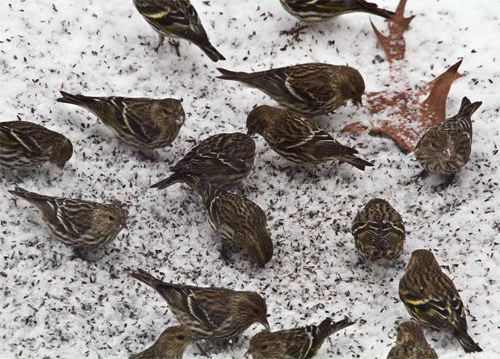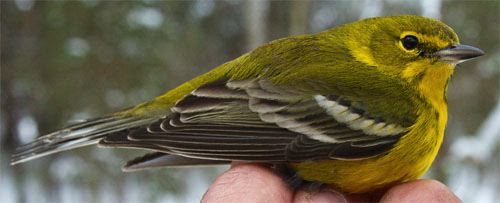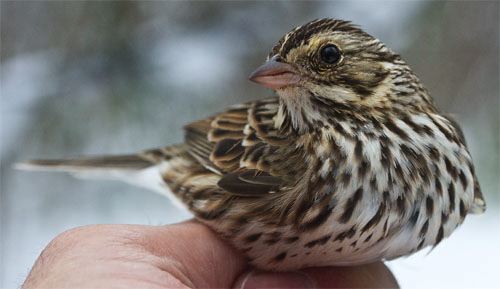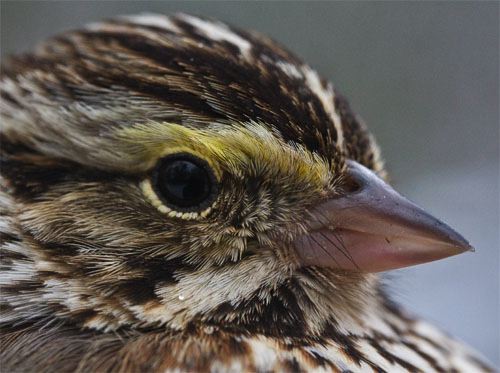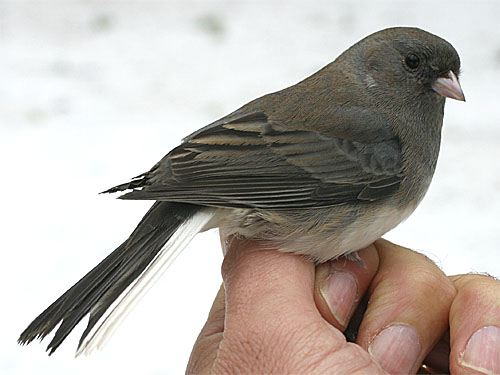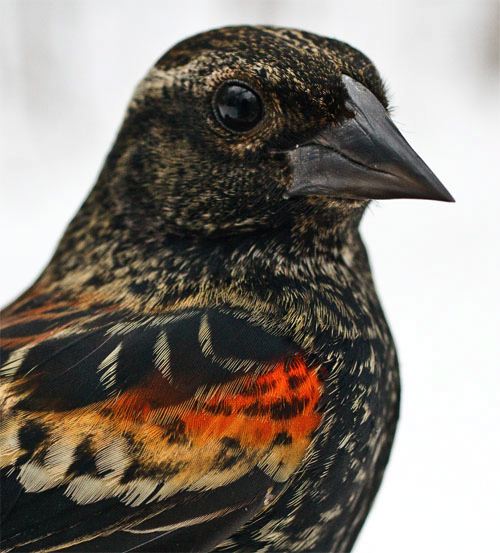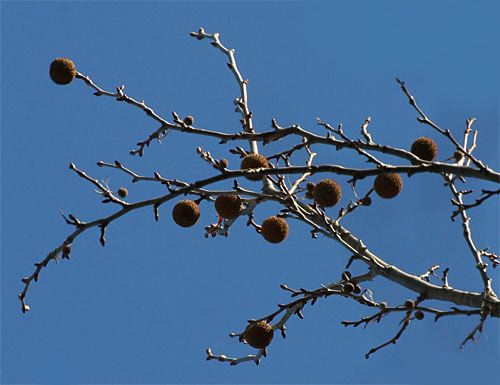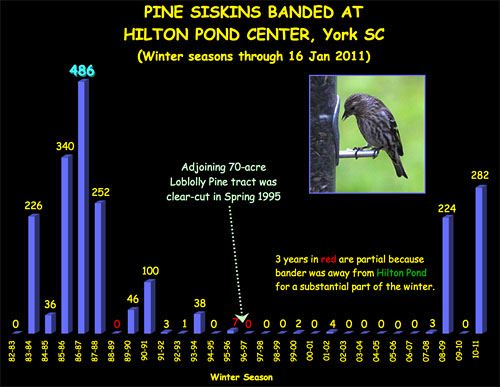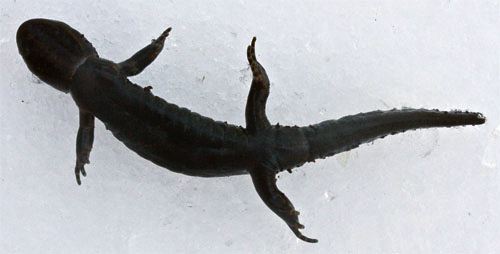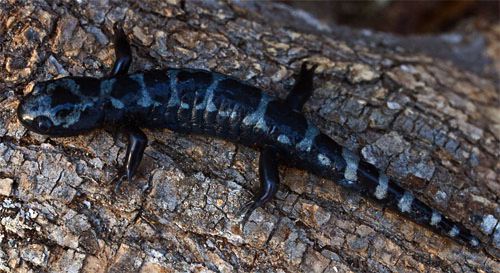|
|
|||
|
|
|
Join fellow birders & educators as citizen scientists on our 2011 |
|
-- 500th INSTALLMENT -- The Web site for Hilton Pond Center for Piedmont Natural History went live on Groundhog Day 2000 with the first abbreviated edition of "This Week at Hilton Pond." Who'd have guessed that almost 11 years later we'd have written and photographed 500 installments! We had planned for this week's 500th posting to be a retrospective of more than a decade's worth of photo essays, but the recent major snow event in the Carolina Piedmont dictates we talk instead about some uncommon weather-related events. Unless something else happens, we'll hold our reminiscing until "NEXT Week at Hilton Pond."
All text, charts & photos © Hilton Pond Center A PERFECT JANUARY SNOWSTORM These days media meteorologists are often a little theatrical when a significant weather event is on its way. Television weathercasters were giddy about the Christmas Day 2010 storm that dumped a few inches of short-lived snow on the Carolina Piedmont, but they were beside themselves this week with news a cold front from Siberia was lumbering south for a collision with humid air from the tropics--sure recipe for a major winter weather happening. This event was forecast so far in advance even weekly newspapers shouted headlines about an impending storm to include snow, freezing rain, sleet, and almost every manner of frozen precipitation, so we were pretty confident snowfall would begin at Hilton Pond Center around sunrise on 9 January 2011. (In anticipation, we even left holiday decorations hanging outside the Center's old farmhouse, above, so we could get photos graced by snow.) Sure enough, the prognosticators--bless their hearts--were right on with their timing and we awoke that Monday to an inch or two of white stuff on the ground, with more falling. We're always grateful to be home at Hilton Pond when it snows, not because we don't like traveling but because snow covers the ground and typically drives birds to feeders and traps. This week, "A Perfect January Snowstorm" did just that: We banded LOTS of birds and got to observe interesting phenomena as varied as ectoparasites, an unexpected amphibian, several seldom-caught birds, and even TWO new animal species for Hilton Pond Center.
All text, charts & photos © Hilton Pond Center On 8 January 2011, the day before the storm, we filled our extensive collection of feeders with all manner of bird food--black sunflower seeds, white millet, cracked corn, shell corn, thistle, and suet--and stored under cover all the wire mesh traps we planned to use to catch birds. Had we left ground traps in place, they might get covered by snow and for those with moving parts the mechanisms might get jammed by ice if snow turned to freezing rain. We did leave hanging two tried-and-true tunnel traps; each contains a small sunflower tube feeder and is protected by a plastic roof that keeps off precipitation. We also left a four-cell Potter trap on a covered platform feeder (above) that also serves as a trap stand. (By the way, we highly recommend these simple, easy-to-make platform feeders that allow for clear observation and photography of birds.)
All text, charts & photos © Hilton Pond Center The snowfall that began before dawn on 9 January continued all morning and afternoon--so heavily that we elected NOT to make great effort to capture any birds. The ground traps stayed dry on the front porch and birds were free to gorge themselves at whatever feeders they chose. In all we caught only two Pine Siskins in the hanging traps that day, plus a second-year Blue Jay in the trap on the platform feeder. The jay was of particular interest because in-hand it appeared to have a single orange feather just beneath its right eye (above). Under a 10X hand lens, however, it was obvious the jay was carrying a cluster of larval seed ticks.
All text, charts & photos © Hilton Pond Center We've seen only a couple of bird ticks this winter--some years they're almost epidemic--so we weren't really expecting ectoparasites on this jay. Although we've seen ticks on many bird species at Hilton Pond Center, most often hosts have been Purple Finches or Dark-eyed Juncos; only a few times before had we seen a tick-bearing jay. The tiny orange larvae, photographed above with a Canon 1X-5X macro zoom lens set at 3X, will go through several stages before reaching their adult size of about 1/16" in diameter (not counting legs)--but that's before each takes a blood meal that causes its abdomen to swell to a rotund 3/8" across (below right). Ticks are usually attached very close to the bird's eye--just the place where a bird cannot safely remove it with its claws. We chose not to treat the Blue Jay or remove the ticks--in our experience that sort of manipulation around the eye usually ends up causing more damage than good--but simply banded and photographed it and released it back into the wild. We're hopeful we can recapture this particular bird later in the winter to see how it--and the ticks-- are getting along. We banded a few more birds before 4 p.m. on 9 January, electing to shut down traps at that hour to allow birds to feed freely before sunset. By early evening the snow had abated but very light freezing drizzle began to fall. Next morning (10 January) we awoke to something we've seldom witnessed--what the weather announcers were calling "Freezing fog." During this curious phenomenon, the dew point and air temperature were close enough for fog to occur, but it was so cold the fog condensed on surfaces and immediately froze--forming a thin, super-smooth glaze of ice on top of what had ended up as 6" of snow. As birds tried to land on the ground, they simply skittered across the ice surface--sometimes for a foot or more before claws finally dug in and stopped forward progress. The ice layer also meant it was difficult for little birds to dig through the snow to feed on soil beneath; because frozen fog had also coated tree buds, cones, and other natural food sources, what nurture we had provided in feeders was about all the birds had. Hmmm. This sounded like "A Perfect January Snowstorm" and an opportunity to catch and band birds, so we went to work.
All text, charts & photos © Hilton Pond Center That morning we still chose not to deploy most of our ground traps, relying instead on just the platform trap, the two hanging traps, and a Wharton trap on the ground under the thistle feeder. (We left the door open on the latter trap just to let the birds get acclimated to it.) We also left all the feeders in place, meaning the birds had plenty of places to feed without getting caught. By 8 a.m. on 10 January birds already were EVERYWHERE; each perch on the big tube dispensers was occupied, suet feeders were under attack, hordes of birds were picking through spillage under the traps (Pine Siskins, above and below), flocks of finches were lined up in trees overhead waiting for the current shift to depart, and the two-sock thistle feeder was covered--with the adjoining hanging trap filled with about as many Pine Siskins as it could hold.
All text, charts & photos © Hilton Pond Center Pulling on our knee boots and warm clothing--the temperature shortly after sunrise was still a chilly 24° F--we grabbed a couple of gathering cages and headed out the front door, avoiding the farmhouse's treacherous icy back steps and carefully breaking a trail from the front porch. As we rounded the corner of the house there was a loud WHOOSH! as a mixed flock containing literally hundreds of birds swooped up and away from the feeding station--something that happened dozens of times during that day when we went out to extricate birds from traps. We gently removed one Pine Siskin after another from the hanging trap and transferred it to a gathering cage; when the trap was cleared we went back inside to the banding table to start processing our captures. We spent literally the whole morning on the 10th repeating this scenario with the two hanging traps and by 2 p.m. had measured, aged, sexed, and banded 95 Pine Siskins! These siskins apparently go to bed early, so things slowed considerably during the afternoon hours--which was fortunate; we admit without shame that banding 95 siskins in six hours brought us near the brink of exhaustion!
All text, charts & photos © Hilton Pond Center Mixed with the siskins in traps on 10 January were a trio of American Goldfinches, two Purple Finches (one red male, one brown of unknown sex), a male House Finch, and a very yellow Pine Warbler (probable male, above). During the day the four-cell Potter trap on the feeder stand also captured five Chipping Sparrows, 11 Dark-eyed Juncos, and four White-throated Sparrows.
All text, charts & photos © Hilton Pond Center By mid-afternoon after the siskins departed we finally had time to breathe, eat lunch, and look a little more closely at birds outside the office window. Our attention was drawn particularly to a small flock feeding beneath one of the sunflower feeders. The Dark-eyed Juncos and rusty-capped Chipping Sparrows were easy to identify, but several other streak-breasted brown sparrows (eating cracked corn, above, between Dark-eyed Junco at left and White-throated Sparrow) didn't quite look right. Although at first we thought they could be Song Sparrows, their posture, short tails, and lack of central breast spots ruled out that species. We thought we knew what the birds really were, but to be sure we decided to deploy a few more Wharton traps on the ground. Amazingly, within a few minutes we actually trapped one of the birds we were after; in hand, there was no doubt it was a Savannah Sparrow.
All text, charts & photos © Hilton Pond Center Savannah Sparrows (above) do look a lot like Song Sparrows and folks sometimes have trouble telling them apart. Most of our experience with the species had been through binoculars in vast open fields at Carolina Sandhills National Wildlife Refuge near McBee SC, where hundreds of them swelled numbers on Christmas Bird Counts we once organized there. Oddly enough, however, we had never banded a Savannah Sparrow at Hilton Pond Center or elsewhere; even more important, this just-trapped individual was a new species for the Center's "Yard List"--our 171st since 1982--and it also became the 125th species banded locally. Yipppee! A new bird species for Hilton Pond!
All text, charts & photos © Hilton Pond Center To repeat, the somewhat smaller Savannah Sparrow resembles a Song Sparrow, but Savannahs lack that central breast spot and their noticeably shorter tail is notched rather than rounded. Many but not all Savannah Sparrows also have a yellow superciliary line (above) and lore--the area between base of bill and eye, similar to but less pronounced than in White-throated Sparrows. One likely reason we've never observed Savannah Sparrows at Hilton Pond is because they're here only half the year--they breed in the northern U.S. and nearly all of Canada--plus they do tend to be more common toward the Coastal Plain. In addition, our once-open but now-wooded 11-acre property isn't so attractive anymore to birds at home in grasslands. Up to five races (subspecies) of Savannah Sparrow are reported from the Carolinas in winter, varying primarily in size and shape of bill and comparative wing and tail lengths, but we were unable to take this bird past the species level.
All text, charts & photos © Hilton Pond Center The Wharton traps on the ground turned out to be pretty productive that afternoon, snaring two MORE Savannah Sparrows, six Dark-eyed Juncos (above), and a female Northern Cardinal. That gave us a total of 126 new birds captured for 10 January 2011--perhaps our most productive banding day in our three decades of work at Hilton Pond Center! Tired as we were from banding all those birds, we could hardly wait to see what the next day would bring, so we were up at the crack of dawn on 11 January. Skies were cloudy with temps still below freezing, and there was more freezing fog to add slightly to the thin layer of ice that coated everything. Even at first light we knew this was going to be a banner day for banding; by 7 a.m. Pine Siskins were already clinging to thistle socks and Purple and House Finches were chowing down on sunflower seed. We couldn't imagine we'd capture more siskins than the day before, but on the 11th we ended up with 133 of them! This brought the two-day total for Pine Siskins to 228--more of this species than we typically would band in an entire WINTER! Adding to the banding totals on the 11th were seven American Goldfinches, six Dark-eyed Juncos, two Chipping Sparrows, two more of those newly arrived Savannah Sparrows, two Northern Cardinals, three Mourning Doves, and two male Red-winged Blackbirds. That made 157 birds banded on 11 January, easily eclipsing the previous day's record of 126 for most bird we've ever captured in one day.
All text, charts & photos © Hilton Pond Center It was nice to get more Savannah Sparrows--that gave us five in two days--but we also were excited to capture Red-winged Blackbirds, mostly because we seldom band them at Hilton Pond Center. In fact, these two were only the 23rd and 24th banded locally in 30 years, and the first since 2004. It was also interesting that although both blackbirds were males they looked very different because one was a subadult that hatched last year in 2010 while the other was at least in his third year. The younger red-wing (above) was still in immature plumage that included an eye line, brown and tan streaking on the head, breast, and back, and speckled shoulders of orange and dull yellow.
All text, charts & photos © Hilton Pond Center The adult Red-winged Blackbird (above) bore jet-black body plumage with intensely red shoulders. His back and crown feathers were edged with rusty brown that will wear off before the upcoming 2011 breeding season. Even though this species was fairly common around Hilton Pond back in the 1980s when the impoundment wasn't surrounded by trees, we never caught many. These days about the only time we see red-wings is when they show up randomly in winter in thousand-bird mixed flocks of various blackbirds and European Starlings. (What with all the Pine Siskins to band this week, we're actually glad one of those huge blackbird curtains didn't descend on our feeders and traps.)
All text, charts & photos © Hilton Pond Center Following those mind-boggling snow banding days on 10-11 January 2011 we weren't quite sure what to expect on the 12th--Day Three of the big January snow event. What we did NOT anticipate is that nearly all birds would abandon the Center's feeding station. By day's end we had banded only TW0 Pine Siskins--quite a drop from 95 and 133 on the days preceding--plus four American Goldfinches, four Chipping Sparrows, two Dark-eyed Juncos, and three more Savannah Sparrows for a total of 15 birds. To go from a hundred or more Pine Siskins at the feeders to just a handful was a real mystery until on a late afternoon walk we found a siskin flock high in American Sycamore trees where they were picking apart seed balls (above). This food source, you'll remember, had been glazed over with a hard icy shell after the snow and freezing fog, but highs just above freezing on the 12th allowed ice to melt. How interesting that despite the unlimited availability of thistle and sunflower seed birds were out chowing down on more natural food as soon as it came available. Click on the image above to open a larger chart version in a new browser window For the snow event's remaining days (13-16 January) banding moved along at a much slower pace. On those days we captured just seven more Pine Siskins; although quite a few continued to visit the thistle feeder they didn't enter the sunflower seed traps. We also banded another Chipping Sparrow, two American Goldfinches, a Northern Cardinal, three House Finches, a Blue Jay, and 18 Purple Finches--just 33 birds in four days and quite a slow-down from the two days following the snowfall. That still gave us 413 birds banded through 16 January of the current calendar year, a mark we didn't reach in 2010 until the final week in April. Pine Siskins helped speed this year's banding pace, of course, and have reached a season total of 282 (see chart above)--making the winter of 2010-11 the third-best-ever for the species in our 30 years of banding research at Hilton Pond Center. As we gaze out the farmhouse windows there are still a dozen or more Pine Siskins partaking of our gourmet thistle seeds, so we wouldn't be surprised to see this year's totals elevate into second place. Now that we spend much of the late winter investigating Ruby-throated Hummingbirds in the Neotropics, however, we doubt we'll ever surpass that 486 siskin total from 1986-87. Just as our current photo essay marks the 500th installment of "This Week at Hilton Pond," we celebrated a number of other milestones during "A Perfect January Snowfall"--including our most productive banding day ever (11 January) with 157 individuals. Sometime that day we also hit the 55,000 mark for birds banded during our 30-year tenure at Hilton Pond Center, which continues to be one of the most active year-round banding stations in the southeastern U.S. And thanks to their current irruption, Pine Siskins (with 2,050 individuals) became the seventh species to join the Center's "2,000 Club" of birds banded--exceeded only by the other three winter finches (Purple Finch, House Finch, and American Goldfinch), Ruby-throated Hummingbird, Northern Cardinal, and Yellow-rumped Warbler; White-throated Sparrows are closing in with 1,997. We'd call that a pretty good January snow week. But wait! That's not all.
All text, charts & photos © Hilton Pond Center As the sun sank ever lower on the afternoon of 12 January, we decided to crunch through the snow and explore the most distant trails at Hilton Pond Center. We again pulled on our knee boots, zipped up our comfy winter clothing, donned a cap, and wandered out past the bird trapping area where for the past few days we had spent most of our waking hours. There were no other human signs along the trails and not much evidence of wild animals. We did find unmistakable prints of Raccoon, Virginia Opossum, and Eastern Cottontail but were surprised not to see any tracks from the small herd of White-tailed Deer that hangs around the property. As we reached the furthest corner of our acreage we headed back along a fence row that borders a neighboring farmer's pasture. Ahead of us on top of the snow we saw a dark silhouette that made us do a double-double-take (above); there was no doubt it was the outline of a salamander!
All text, charts & photos © Hilton Pond Center Now of all the things we might expect to find on a post-snowstorm jaunt through January woods in the Carolina Piedmont, salamanders would not be very high on the list. We picked up the out-of-place amphibian and recognized it as a Marbled Salamander, Ambystoma opacum, a species new to Hilton Pond Center! The specimen, likely a female, was still flexible despite freezing temperatures, so we held it in our hand inside a pocket for the walk back to the farmhouse. Before departing, however, we carefully examined the entire area and found no tracks of any kind, indicating the salamander probably hadn't gotten there on its own; it also didn't appear that a predator had walked in with it. Back at the Center we placed the chilly amphibian in a bowl of lukewarm water on the outside chance it might be revived. Unfortunately, it never showed signs of life, so we posed and photographed it on a chunk of firewood (above) as documentation of this strange occurrence. We're still not sure how the Marbled Salamander got to where we found it, but our best guess is that a bird--perhaps one of those American Crows we'd seen earlier in the day eating corn--grabbed the amphibian from shallow water along the edge of Hilton Pond before flying over the trail and accidentally dropping it. Or maybe not. A salamander in the snow in mid-winter might just be one of those mysteries of nature for which we'll never have the real answer.
All text, charts & photos © Hilton Pond Center Despite a high of 52 degrees on 16 January there was still a good bit of snow on the ground at Hilton Pond Center--a full week after it began to fall on the morning of the 10th. We wouldn't be surprised if some of the white stuff lingers in shady places on into next week, and you can check on this yourself via the Hilton Pond Webcam courtesy of Weather Underground. This was indeed a great week to be home where we could capture a new bird species, add a salamander to the yard list, reach a one-day high and the 55,000 mark for banded birds, celebrate the 500th installment of "This Week at Hilton Pond," and enjoy the uncommon Carolina opportunity to watch white stuff come and go in a "A Perfect January Snowstorm." All text, charts & photos © Hilton Pond Center
|



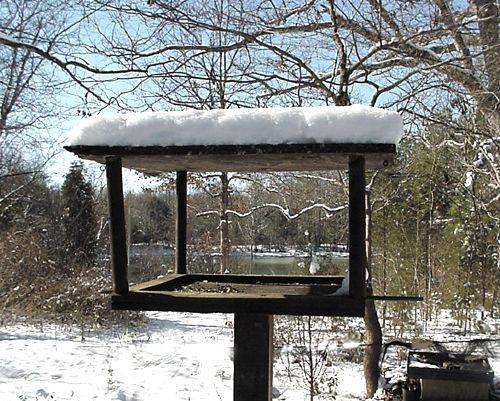
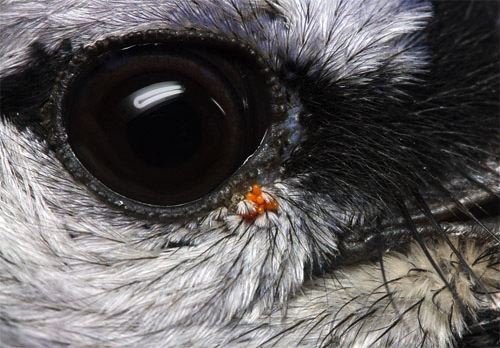
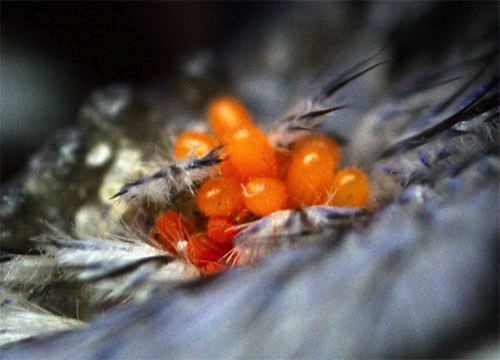
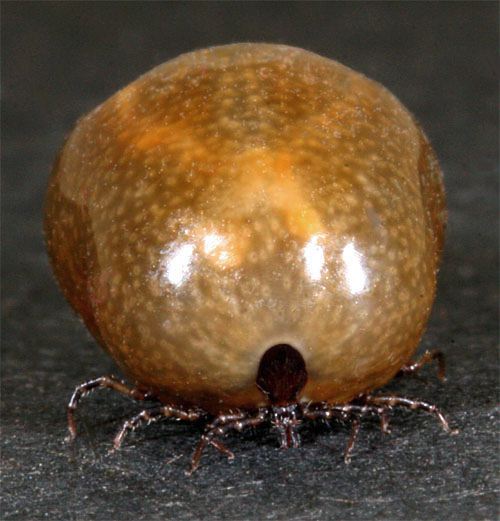 Our guess is that some larval ticks on the jay above will simply fall off and die or end up on some other bird, while others will migrate to a different location on the jay's head.
Our guess is that some larval ticks on the jay above will simply fall off and die or end up on some other bird, while others will migrate to a different location on the jay's head.